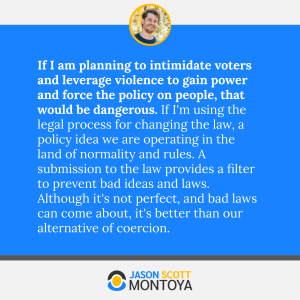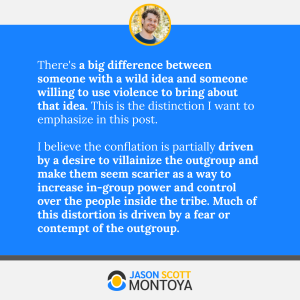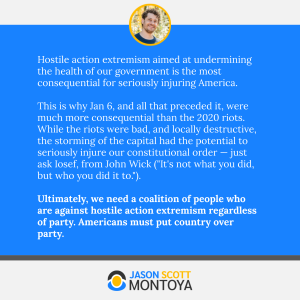
But They're Extreme! The Type of Extremism That Is Most Dangerous and Why It Matters More Than Policy Differences
The word extremist is loosely thrown around to label political rivals as an insult or out of fear of what they might do. It's a way to scare people deeper into their political party or to give us justification to stay inside of the one we don't want to leave or speak out against.

Usually, the extremism label is applied to those who are perceived to have extreme policy ideas. However extreme policy ideas are not inherently problematic.
For example, I've got a policy idea that the government should give new mothers money to help promote motherhood and prevent abortions. This is an extreme idea. I've got others like adding a fourth branch of the federal government and ratifying a declaration of vision to compliment and clarify our declaration of independence. Do these radical ideas make me dangerous? No. Why not?
Because I'm not going to use mass deception, terror, and violence to enact it. The type of extremism that's dangerous is when I use hostile means. If I'm using legitimate means, like passing a bill in Congress, to bring an idea about, that would not be inherently dangerous. It could be a bad law, but it's not the type of extremism that we need to be most vigilant about.
If I am planning to intimidate voters and leverage violence to gain power and force the policy on people, that would be dangerous. If I'm using the legal process for changing the law, a policy idea we are operating in the land of normality and rules. A submission to the law provides a filter to prevent bad ideas and laws. Although it's not perfect, and bad laws can come about, it's better than our alternative of coercion.
People who are afraid of policy ideas tend to not understand mechanically how these policies are developed and rolled out, as well as how difficult it is to enact non-bi-partisan legislative change. When we understand the system, it helps us appreciate its value and the actual risks.
Hostile Action
"the belief system that an in-group’s success or survival can never be separate from the need for hostile action against an out-group."
The key here is the differentiation between the friend and foe, and what's required to stop the foe. The outgroup is the enemy, and the only way to stop them is through hostile action. This is layered in a tribal morality that elevates the worth of people inside our group above those outside of it.
What are some general examples of this type of hostile action?
One simple way to know what falls in that category is the types of actions that fall outside of the normal spectrum of political involvement like voting, debate, and legislative change.
Mass deception, hate speech, threats, discrimination, intimidation, cyberbullying, property damage, and physical violence directed at those people in the outgroup (those the group deems inferior) would be included in the category of hostile-action.
So, When You Use The Word, What Do You Mean By Extremism?
Many people are afraid of ideas and policies they don't like or think would be detrimental. They may be right.
But rhetorically, we've subtly moved into a communication space where people have conflated hostile-action extremism with extreme policy ideas.
There's a big difference between someone with a wild idea and someone willing to use violence to bring about that idea. This is the distinction I want to emphasize in this post.
I believe the conflation is partially driven by a desire to villainize the outgroup and make them seem scarier as a way to increase in-group power and control over the people inside the tribe. Much of this distortion is driven by a fear or contempt of the outgroup.
Simply put, for example, Republicans villainize Democrats to make them and their ideas seem scarier so Republicans are more deeply entrenched in the group and independents are more leery about supporting Democrats. And the same can happen the other way around with Democrats and Republicans.
But this misplaced concern is why I, as a Republican, am not automatically afraid of more justices being added to the court or changing the electoral college. These require a large majority and legislative bills to make happen. As long as our leaders are following the rules for how to change rules, I'm not primarily concerned about idea extremism, in an urgent sense.
Hostile-Action Extremism Examples That Should Deeply Concern Us
Here are the types of hostile-action extremism I'm concerned about and have unfolded over the last several years.
-
Politically motivated mass shootings in Charleston, El Paso, and Buffalo.
-
Police brutality on citizens, specifically George Floyd.
-
The violent and destructive riots of 2020.
-
The violent attack on Nancy Pelosi's husband.
-
The foiled attack on Supreme Court Justice, Brett Kavanaugh.
-
The foiled kidnapping attempt of Gretchen Whitmer.
-
The attempted assassination attempts on Donald Trump.
-
The increasing number of threats and intimidation of election workers and judges in 2020, 2022, and 2024.
This is not an exhaustive list, but it illuminates the type of hostile-action extremism that is most dangerous. When we believe that normal democratic and representative processes are no longer viable options for change and are willing to resort to hostile action, we've entered a dark place.
What's deeply troubling is how much this type of hostile-action extremism has taken over the Republican Party and is embodied in it from the top.
On September 18th, 2024, 200 Republican national security leaders publicly endorsed Kamala Harris for president over Trump. They emphasized in their letter how much of a threat Trump poses to our country, as it relates to hostile action extremism.
"by inciting the violent attack on the Capitol on January 6, 2021 and defending those who committed it, he has violated his oath of office and brought danger to our country. As former Vice President Pence has said "anyone who puts himself over the Constitution should never be President of the United States."
You can read their full letter here where they list out the national security reasons to support Kamala Harris.
When Hostile Action Extremism Threatens Our Country
Ideas held by a minority are not the same type of thing as people willing to use hostility (Mass deception, hate speech, threats, discrimination, intimidation, bullying, property damage, and physical violence) to move their agenda forward.
When that agenda intersects with the health of our democratic republic, we are at the highest risk point.
It's also important to note the consequential nature of different types of hostile-action extremism. Some of these hostile-action extremist events are more consequential to America than others.
Hostile action extremism aimed at undermining the health of our government is the most consequential for seriously injuring America.
This is why Jan 6, and all that preceded it, were much more consequential than the 2020 riots. While the riots were in this category, and locally destructive, the storming of the capital had the potential to seriously injure our constitutional order — just ask Iosef, from John Wick ("It's not what you did, but who you did it to.").
Ultimately, we need a coalition of people who are against hostile action extremism regardless of party. Americans must put country over party.
As you consider the presidential candidates, ask yourself the following question.
Since 2020, have they moved towards or away from hostile-action extremism?
Additional Resources
- Watch: The Rise of Christian Extremism and the Path Back to Peace — Discussing the Kingdom of Rage With Elizabeth Neumann
- Watch: Interview: Changing Hearts — Loving Those Who Hate You — With Daryl Davis
- Read: Reject Political Violence & Embrace The Way of Non-Violent Political Participation
- Read: The 2024 Presidential Election Is Not About Policy: Understanding the Impending Authoritarian Political Landscape
- Watch: Democracy First Discussion with Historian Joanne Freeman on American History and Political Violence
Share This on Social Media!

















